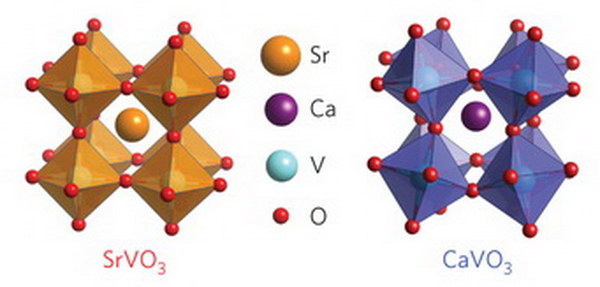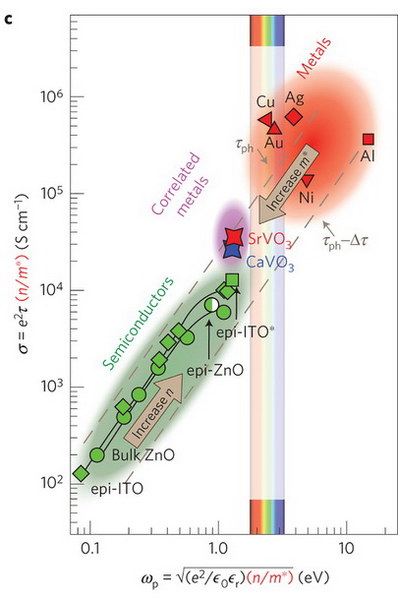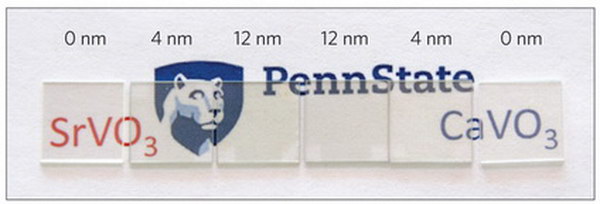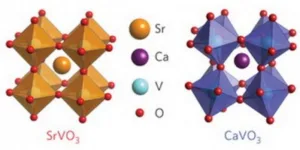
I had previously written about perovskites as laser materials and wavelength conversion materials in competition with Quantum Dots (QDs). (See my Display Daily on Perovskites and my companion DD on Quantum Dots). Now I have learned that perovskites have another display-related application: potentially they can be used as transparent conductive coatings in both LCD cells and touch screens. This is especially important because the dramatic increase in touch screens has driven up the demand for indium for use in ITO. Solar cells are also a major user of ITO. Fear is this increased demand will eventually drive up the price indium as well, although it has been relatively stable in the 2010 – 2016 time frame in the range of $540 – $695 per kilogram. Further in the past, spikes have driven the price over $1000 per Kg.
A report was published on-line in Nature Materials 14 December 2015 titled “Correlated metals as transparent conductors,” (doi:10.1038/nmat4493) by graduate student Lei Zhang and Professor Roman Engel-Herbert at Pennsylvania State University and their 13 colleagues from PSU, Rutgers University and the University of Toledo. The “correlated metals” referred to in the title refer to materials where the motion of pairs of electrons were correlated with each other. The two specific correlated metals used in this study were strontium vanadate and calcium vanadate (SrVO3 and CaVO3). Both of these materials have a perovskite crystal structure, as shown in the figure.
 The perovskite structure of strontium vanadate and calcium vanadate
The perovskite structure of strontium vanadate and calcium vanadate
Lei Zhang, lead author on the Nature Materials paper and named as co-inventor with Professor Engel-Herbert on the patent application said, “I came from Silicon Valley where I worked for two years as an engineer before I joined the [PSU Materials Science and Engineering] group. I was aware that there were many companies trying hard to optimize those ITO materials and looking for other possible replacements, but they had been studied for many decades and there just wasn’t much room for improvement. When we made the electrical measurements on our correlated metals, I knew we had something that looked really good compared to standard ITO.”
In correlated metals such as these perovskites, the motion of electrons in pairs is correlated. This effectively increases the mass of the electron. These higher effective mass electrons can still freely conduct electricity at low frequencies but at the frequencies corresponding to visible light, they do not respond as well as the free electrons in normal metals. Since the electrons do not respond to the light, the passage of the light is not affected by the electrons, i.e. the materials are transparent. Electrons in semiconductor materials such as ITO also respond poorly to the light. Unfortunately, they are also relatively poor conductors of low frequency current as well, as is shown in the figure. The authors describe this effect in non-quantum mechanical terms as the electrons in correlated metals are moving more like a liquid compared to the way they move in a true metal, which is more like a gas.
 Optimization of electrical conductivity under the constraint to keep free carrier reflection edge, represented by screened plasma frequency (ωp) below the visible spectrum.
Optimization of electrical conductivity under the constraint to keep free carrier reflection edge, represented by screened plasma frequency (ωp) below the visible spectrum.
For maximum transparency, it is desirable to have the screened plasma frequency (ωp) of a material below the frequency of the light to be transmitted. This figure shows that this is true of both correlated metals and various forms of ITO but is not true of metals. A second desirable property is to have the highest possible conductivity (σ). This figure shows correlated metals as being superior to even the best forms of ITO. This improved conductivity will allow the use of thinner layers compared to the required thickness of ITO layers in display applications. This transparency is shown in the following figure for various thicknesses of both SrVO3 and CaVO3.
 Transparency of the perovskites SrVo3 and CaVO3 at various thicknesses
Transparency of the perovskites SrVo3 and CaVO3 at various thicknesses
Professor Engel-Herbert commented, “Our correlated metals work really well compared to ITO. Now, the question is how to implement these new materials into a large-scale manufacturing process. From what we understand right now, there is no reason that strontium vanadate could not replace ITO in the same equipment currently used in industry.”
These correlated metal Perovskites will not only be better than ITO, they will be dramatically less expensive. Vanadium currently sells for around $25 a kilogram, less than 5% of the cost of indium, while strontium is even cheaper than vanadium (see Indium Prices High but Fairly Stable for more on this). The thinner films needed also reduce the amount of the required materials, further reducing the cost. While this research is still at the University research level, this quality improvement coupled with the dramatic cost reduction is likely to grab the interest of ITO users, including displays and solar cell manufacturers. If the materials can use the existing production equipment as Professor Engel-Herbert suggests, that’s a major added bonus. –Matthew Brennesholtz

